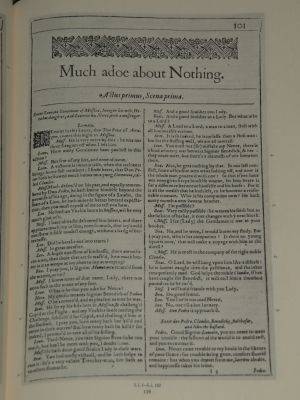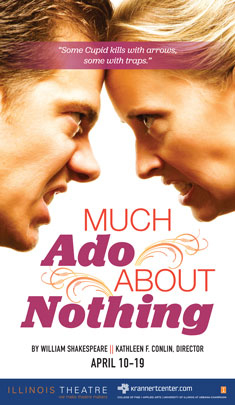 It’s time for us to talk about Shakespearean vaginas, dear readers, so get your kiddies busy elsewhere, while we get down to it…so to speak. Now, before you stone me for being a crass misogynist and an arrogant blasphemer who disrespects the Bard, just hear me out. Shakespeare was a writer for the people, and he communicated with them at their level. His is street-fair theatre, even if he was not a he, or was several hes, or was a beard for multiple exiled writers. In grad school, we read an article which proposed that if Shakespeare were a contemporary playwright, he’d be writing for soap operas, or late night cable. The author pointed to the “commoner’s nobility” aspect of his work and how most of the royals were depicted as either comic buffoons or tragically dysfunctional monsters. The author went on to explain that, the cruder elements of his works — such as the gutter slang reference in the title of Much Ado About Nothing — would not have been embraced by the aristocracy but would have certainly made the working class giggle with glee or shudder with terror at his saucy couplets. The main point of this critic was that our reverence for Shakespeare needs taken down a notch or two so it can be played with through various production methods and then become the lighter, more accessible fare it was meant to be.
It’s time for us to talk about Shakespearean vaginas, dear readers, so get your kiddies busy elsewhere, while we get down to it…so to speak. Now, before you stone me for being a crass misogynist and an arrogant blasphemer who disrespects the Bard, just hear me out. Shakespeare was a writer for the people, and he communicated with them at their level. His is street-fair theatre, even if he was not a he, or was several hes, or was a beard for multiple exiled writers. In grad school, we read an article which proposed that if Shakespeare were a contemporary playwright, he’d be writing for soap operas, or late night cable. The author pointed to the “commoner’s nobility” aspect of his work and how most of the royals were depicted as either comic buffoons or tragically dysfunctional monsters. The author went on to explain that, the cruder elements of his works — such as the gutter slang reference in the title of Much Ado About Nothing — would not have been embraced by the aristocracy but would have certainly made the working class giggle with glee or shudder with terror at his saucy couplets. The main point of this critic was that our reverence for Shakespeare needs taken down a notch or two so it can be played with through various production methods and then become the lighter, more accessible fare it was meant to be.
(For anyone who doesn’t know what all this has to do with vaginas, I’ll explain. In Elizabethan slang, “nothing” was a term used for vagina. Get it? “A nothing?” “An O-thing.” Now that you know that, go back and think about every great scene in Shakespeare’s canon between a man and a woman an think about how and when the word “nothing” was used. Not so highbrow now, is it? You’re welcome!)
 The current production of Much Ado About Nothing playing at Krannert Center for the Performing Arts seems to have taken this stance to heart with a light and breezy evening of delightful theatre helmed by the skilled veteran director Kathleen F. Conlin (pictured, right). This enchanting adaptation, like many recent film adaptations of the work, moves the action from Shakespearean times to a more current setting — in this case, 1900s Messina, Italy. As Conlin states in her director’s note, “We set the time period as the early 1900s, before the shock of world wars impacted both the scenic countryside and the social fabric of small communities. Here in Leonato’s enveloping estate, family and community are the safe haven for young women in the throes of romantic fantasies, soldiers in need of respite after a brief skirmish, and a collection of inept but good-intentioned local officials demonstrating their civic duty. Food, drink, and dancing all contribute to the lusty, earthy rhythm of daily life lived to its fullest in this seaside town.”
The current production of Much Ado About Nothing playing at Krannert Center for the Performing Arts seems to have taken this stance to heart with a light and breezy evening of delightful theatre helmed by the skilled veteran director Kathleen F. Conlin (pictured, right). This enchanting adaptation, like many recent film adaptations of the work, moves the action from Shakespearean times to a more current setting — in this case, 1900s Messina, Italy. As Conlin states in her director’s note, “We set the time period as the early 1900s, before the shock of world wars impacted both the scenic countryside and the social fabric of small communities. Here in Leonato’s enveloping estate, family and community are the safe haven for young women in the throes of romantic fantasies, soldiers in need of respite after a brief skirmish, and a collection of inept but good-intentioned local officials demonstrating their civic duty. Food, drink, and dancing all contribute to the lusty, earthy rhythm of daily life lived to its fullest in this seaside town.”
The transplanting of the play’s action is a wise one, giving the atmosphere a sweet innocence where a virgin’s seeming indiscretion can result in social upheaval and, mostly, comic carnage, without the menacing tone of the antiquated notion of men’s ownership of women clouding the fun. Aided by a lovely and airy set design by Paul Owen (sir, that fountain was to die for, and the ease of movement from scene to scene is a credit to your intelligent design elements), the rich glow created by lighting designer, Robert Perry, and the breezy and detailed costuming of Anne Kenney, Conlin’s production is first-rate Shakespearean comedy with conflict, complications, romance, and Marx- Brothers pacing.
My only miniscule quibble with the production aspects of the piece would be the soldiers’ entrance in full dress uniform that included some amazingly awkward — yet period correct — feathered hats that would make my Aunt Mabel salivate with Sunday bonnet rapture. The hats were fabulous, to be sure, but they also made the soldiers look at bit like refugees from a Mae West haberdashery. However, this is quickly resolved, for, as the soldiers ease into casual civilian-wear, they adorn the stage with a handsome and laconic charm.
 Conlin has cast a group of first-rate actors in her piece and has directed them to be frenzied but articulate throughout. The results are a delight to behold. This is a show about couples and coupling, the most dynamic of which is Beatrice and Benedict, portrayed by the engaging Dina Monk and Thom Miller. Monk is a younger talent, and her ease with the role takes a moment or two to spark; but, as soon as that fuse it lit, she gives Beatrice a delightful contemporary edge and a strong flirtatious manner. Miller is an arrestingly handsome chap who also gives his speeches and musings a cheeky and current wit. Both are unwilling victims of Cupid’s arrow (not to mention their friends’ ministrations), and watching them dance about their mutual fate is a lovely thing, indeed. As the young lovers, Hero and Claudio, Martasia Jones is a delicate beauty and Ryan Smetana is a Disney prince with manically groomed hair and an appropriate sense of romance and indignation. Hero’s father, Leonato, portrayed by Robert Ramirez is a loving parent and perfect host, and Neal Moeller’s commander of the guard, Don Pedro, is a mischievous matchmaker for Benedict and a stalwart friend to Claudio. As the villains of the piece, Christopher Terrell Brown’s Don John is malevolent without becoming mustache-twirling, and Nick Narcisi’s Borachio has a sexy swagger that would make any good maiden contemplate sacrificing her virtue…and the shiny boots and dangling suspenders don’t hurt the fantasy one bit. A comic standout of the night is Robert Gerard Anderson’s Dogberry, who steals every scene he is in, with the delightful support of his Keystone Cop entourage of George Seacoal, Hugh Oatcake, Sidney Germaine, Brian Krause, Ninos Baba, and David Mor. Lastly, Jordan P. Pettis makes a handsome Balthasar, and his singing voice is a lovely surprise addition to the evening’s merriment.
Conlin has cast a group of first-rate actors in her piece and has directed them to be frenzied but articulate throughout. The results are a delight to behold. This is a show about couples and coupling, the most dynamic of which is Beatrice and Benedict, portrayed by the engaging Dina Monk and Thom Miller. Monk is a younger talent, and her ease with the role takes a moment or two to spark; but, as soon as that fuse it lit, she gives Beatrice a delightful contemporary edge and a strong flirtatious manner. Miller is an arrestingly handsome chap who also gives his speeches and musings a cheeky and current wit. Both are unwilling victims of Cupid’s arrow (not to mention their friends’ ministrations), and watching them dance about their mutual fate is a lovely thing, indeed. As the young lovers, Hero and Claudio, Martasia Jones is a delicate beauty and Ryan Smetana is a Disney prince with manically groomed hair and an appropriate sense of romance and indignation. Hero’s father, Leonato, portrayed by Robert Ramirez is a loving parent and perfect host, and Neal Moeller’s commander of the guard, Don Pedro, is a mischievous matchmaker for Benedict and a stalwart friend to Claudio. As the villains of the piece, Christopher Terrell Brown’s Don John is malevolent without becoming mustache-twirling, and Nick Narcisi’s Borachio has a sexy swagger that would make any good maiden contemplate sacrificing her virtue…and the shiny boots and dangling suspenders don’t hurt the fantasy one bit. A comic standout of the night is Robert Gerard Anderson’s Dogberry, who steals every scene he is in, with the delightful support of his Keystone Cop entourage of George Seacoal, Hugh Oatcake, Sidney Germaine, Brian Krause, Ninos Baba, and David Mor. Lastly, Jordan P. Pettis makes a handsome Balthasar, and his singing voice is a lovely surprise addition to the evening’s merriment.
This is typically not one of my favorite Shakespearean comedies due to the grim turn taken by the script during the younger lovers’ nuptials, but Conlin’s production is an energetic evening of theatre, and her skillful use of a talented cast does Illinois Theatre and Krannert Center proud. I highly recommend this production and look forward to seeing more from the U of I’s artists in future seasons.








